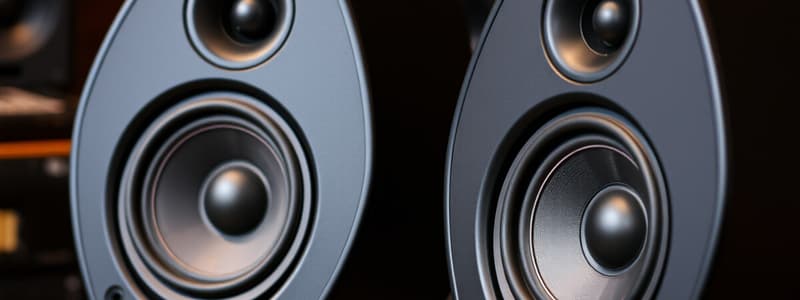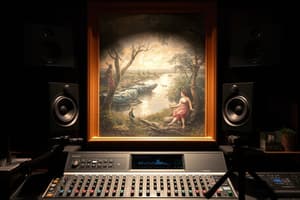Podcast
Questions and Answers
The distance between the monitors and the listener should be an ______ triangle.
The distance between the monitors and the listener should be an ______ triangle.
equilateral
Monitors should be set so that the speakers are at the same height as the listener's ______ when seated in the mix position.
Monitors should be set so that the speakers are at the same height as the listener's ______ when seated in the mix position.
ears
If monitors are placed too close, the stereo field could be ______ (no spacial definition).
If monitors are placed too close, the stereo field could be ______ (no spacial definition).
narrow
Decoupling monitors helps reduce ______.
Decoupling monitors helps reduce ______.
One reason mixing is not recommended at high volume levels is ______ fatigue.
One reason mixing is not recommended at high volume levels is ______ fatigue.
Mixing at low volume allows an individual to work for longer ______.
Mixing at low volume allows an individual to work for longer ______.
Mixing at lower volumes helps mixes better translate across different listening ______.
Mixing at lower volumes helps mixes better translate across different listening ______.
Adding rubberized feet/pads is a way to ______ a monitor.
Adding rubberized feet/pads is a way to ______ a monitor.
Listening to a mix in ______ can help identify phase, balance, and panning issues.
Listening to a mix in ______ can help identify phase, balance, and panning issues.
Mixes can sound different in different ______, such as on a television, car, or portable music player.
Mixes can sound different in different ______, such as on a television, car, or portable music player.
To overcome potential acoustic problems, reflective surfaces should be identified, speakers should be placed properly, and room ______ calculated.
To overcome potential acoustic problems, reflective surfaces should be identified, speakers should be placed properly, and room ______ calculated.
Placing monitors directly against a wall can lead to the listener hearing bass ______ and not the speakers.
Placing monitors directly against a wall can lead to the listener hearing bass ______ and not the speakers.
Room treatments such as diffusers and bass traps can also treat ______ areas.
Room treatments such as diffusers and bass traps can also treat ______ areas.
Flashcards are hidden until you start studying
Study Notes
Monitor Speaker Setup
- Position monitor speakers to form an equilateral triangle with the listener.
- Align the height of monitors to ear level when seated.
- Angle monitors correctly to prevent "smearing" of the stereo field.
Effects of Monitor Placement
- Monitors too close result in a narrow stereo field with lack of spatial definition.
- Monitors too far apart may weaken the center image; the "sweet spot" might be behind the listener.
Importance of Decoupling
- Decoupling reduces resonance, providing a more accurate bass response.
- Uncoupling minimizes energy transfer from monitors to surfaces they sit on.
Methods of Decoupling
- Place monitors on stands rather than desks.
- Use rubberized feet or pads to mitigate vibrations.
- Fill stands with sand or gravel for additional damping.
Risks of High Volume Mixing
- Causes ear fatigue over extended sessions.
- Increases risk of ear damage.
- Can lead to false perceptions of the mix, impacting frequency translation.
- May introduce skewed stereo image and balance issues.
Benefits of Low Volume Mixing
- Allows for longer work periods without fatigue.
- Protects hearing, preserving long-term listening ability.
- Enhances judgment of stereo image and frequency balance.
- Facilitates clarity of smaller details and better translation across different environments.
Advantages of Mixing in Mono
- Identifies phase, balance, and panning issues.
- Helps detect out-of-phase wiring in monitors.
- Ensures adjustments are made with regard to balance.
- Acknowledges that many listeners use mono devices, enhancing mix compatibility.
Value of Multiple Speaker Systems
- Mixes can be perceived differently across various playback systems (e.g., TV, car, portable players).
- Testing on multiple systems aids in identifying translation issues that may not arise on primary monitors.
Addressing Acoustic Problems
- Identify reflective surfaces and position speakers appropriately.
- Calculate room modes to ensure the 'sweet spot' is free from build-up and reflections.
- Utilize acoustic treatments such as diffusers and bass traps to improve sound quality.
Avoiding Wall Placement for Monitors
- Placing monitors against a wall can cause bass buildup, leading to an inaccurate bass perception while mixing.
- This misrepresentation may lead to poor mix translation in various listening environments.
Studying That Suits You
Use AI to generate personalized quizzes and flashcards to suit your learning preferences.




